Keeping lawns, trees, bushes and flowers healthy and attractive is a big goal for nearly all condos and HOAs—and meeting this goal means that effective landscaping management is essential. Aside from the sun, soil rich in nutrients, and a capable, qualified landscaping staff, the key to remaining “green” is water access. Depending on the location of an association, H20 can be a sporadic resource, requiring the implementation of irrigation technologies that themselves require maintenance and oversight.
Thirsty Land
According to the U.S. Census Bureau, as of 2013 South Florida’s population exceeds 5.8 million residents. And while other regions of the nation have higher numbers of residents per capita, South Florida is unique in that its average temperature is 82 degrees. Between population density and climate, the area's lush, tropical environment requires more water than most areas of the country.
“Golf courses, nurseries, cemeteries, public parks and large communities with common systems use the most water per source,” says Jack Baldwin, a licensed irrigation contractor with the Pompano Beach-based Ted Conner Landscaping Inc. “Single family homes account for a large portion of irrigation as a whole, but with more single source water connections.”
Baldwin adds that topographical and climate-related issues also determine which areas will require more water than others. “Open areas without shade and more exposure to sun will dry faster and need more water. And some plant species require more water than others,” he continues. “Soil conditions can cause water to not get to root zones for the plant to survive. Sandy soil allows water penetration quickly, while loam and clay causes water to run off and sometimes be wasted.”
A Changing Industry
The irrigation industry has changed significantly over the last two decades, say the pros. For homeowners associations, these changes matter.
Tom Balling, the president and a partner with Treasure Coast Irrigation & Landscape in Hobe Sound, explains that many condominium developments were built more than 30 years ago, and these communities' irrigation systems are either outdated or seriously in need of upgrades. According to Balling, “The condominium and HOA market in South Florida really boomed in the 1970s, so we are starting to see a lot of retrofit opportunities where the communities’ polyvinyl chloride (PVC) infrastructure is shot.”
Balling notes that today’s irrigation products are designed for water conservation and uniform water distribution. Irrigation heads have been designed to better distribute water, for example. Nozzles in the head as well as the head itself are shaped and designed to allow the installer to regulate the amount of water applied as well as area covered. Additionally, irrigation system clocks can now control the timing of the watering far more efficiently, and allow the user to program according to the specific needs of the plant material and any local water regulations.
Fresh Material
In recent years, High density polyethylene (HDPE) pipe has become a leading alternative to PVC piping systems. While the PVC irrigation became popular in the 1960s, systems eventually began to break down. Balling explains that the reason was due, in part, to the gluing process required for PVC joints. HDPE is fused together by heat and pressure. A HDPE system, he says, could last 100 to 300 years. “HDPE is becoming the go-to material for retrofitting a community’s system,” says Balling. “In fact, we just did one in Deerfield Beach, which has been a three year-long project.”
That project included a conversion from a PVC system to HDPE. The system serviced an HOA with 20,000 residents. The old system, built in 1973, had 43 pump stations, which was reduced to three stations. “We took the PVC infrastructure and converted to HDPE along with a new water distribution method with new water conversation nozzles that will save them 60 to 70 percent in water usage,” says Balling.
While he agrees that an HDPE system can last upwards of 100 years, Baldwin says that the useful life of any irrigation system can be greatly extended with proper maintenance. On average, PVC piping can last well over 50 years, he notes. “Controllers can last 10 to 15 years if properly installed and grounded and most heads will last 5 to 10 years, some even longer. The seals are usually the first to show signs of wear.”
Baldwin also acknowledges that new technologies have had a positive impact on the industry. Aside from HDPE, he points to irrigation controllers or timers with water-saving options built to fit any landscape irrigation system. “Twenty or 30 years ago, we did not have digital controllers to allow zones to run separately,” he says. “More recently pressure-regulated heads have eliminated misting and losing water to immediate evaporation before the water hits the plants or sod.”
Water Rules
Cheryl Harris, executive director of the Florida Irrigation Society based in St. Petersburg notes that the state mandates certain rules and regulations for irrigation systems and the contractors who install and maintain them. For example, Florida Statute 373.62 requires a licensed contractor to install irrigation systems. The professionals must test for “correct operation of each rain/moisture sensing shutoff device. If the sensor is not in operating condition, a licensed contractor must repair or replace and verify it is in working condition.”
The aforementioned statute is important because on average, South Florida receives 60 inches or more of rain each year. While that may seem to be an adequate amount of water, Balling said it’s important to note when the rains actually falls. “We have a serious timing issue in Florida. Sixty to 70 percent of our rainfall happens in the five-month period between July and October,” says Baldwin. “We have seven months of the year where landscapes require supplemental irrigation.”
Good Design and Best Practices
For homeowners associations, landscaping needs and irrigation requirements will differ from property to property. Two associations located just a few miles apart may have radically different irrigation needs. Topography, erosion and soil composition are critical variables. Landscape and irrigation professionals have to determine the amount water needed for an area, the size of area and shape of area being irrigated as well as the type of plant material involved. Knowing the area that is being irrigated is critically important in the designing of the system, notes Baldwin. “An improperly planned irrigation system can cause serious problems—including environmental impacts, like improper backflow prevention devices or cross connections into city systems. This can lead to human fatalities, which is why professionals should be used in this industry,” says Baldwin, adding that “The biggest mistake in the industry is mixing rotor heads and spray heads on a same zone. Proper heads and nozzles on the same zone are critical for equal precipitation rates. This is absolutely the most common mistake made in the industry, and it wreaks the most havoc.”
Government agencies also have an influence on how condo and HOA communities manage their irrigation needs. “Condominiums and HOAs have stipulated green spaces that they are responsible for, so irrigating those green spaces definitely is critical,” says Balling. “The South Florida Water Management District is getting more involved than ever to ensure that these communities are using water properly and efficiently. Every HOA has an allotment of water—so they are under scrutiny,” he says.
Balling adds that concerned board members should visit http://www.sfw md.gov for information on irrigation system best practices and water conservation laws, which can vary by jurisdiction.
Doing In-House
While tending flowerbeds and watering shrubs can sometimes be handled by HOA staff or even residents themselves, irrigation is not something to do-it-yourself. Balling encourages homeowners associations to hire certified water auditors and irrigation designers to make sure their project is handled properly and professionally. These professionals will identify the sources of water, water pressure, soil types, slopes, prevailing winds and other site specifics to determine an appropriate plan. Taking all this into consideration, a design will be drawn up in a computer-aided design (CAD) program.
“There are some good consulting firms out there that can do an analysis of water usage, efficiency of existing system and the maturity of the landscape,” he says. “Then these firms develop a design and then it goes to bid to folks like us.”
Whether a new HDPE system or an upgraded PVC system, all irrigation systems require continued maintenance to ensure all mechanicals are working properly and that the right amount of water is being used. “We recommend every system to run at least one time per week, even if it is only for one minute. This helps prolong the life of the heads and valves. Systems should be turned and checked monthly,” says Baldwin. “This maintenance is for cleaning nozzles, ensuring proper valve operation and flushing out any debris which may have gotten into the system.”
The bottom line is that irrigation is a complicated issue situated at the intersection of environmental concerns, conservation law, and engineering, and requiring the expertise of an array of professionals to do properly. So when it's time for your community to install a new system for your landscaping, or just update or repair an existing system, understanding the stakes and choosing the right professionals to help is key not only to keeping your grounds lush and green but also staying on the right side of the law.
W.B. King is a freelance writer and a frequent contributor to The South Florida Cooperator.





Leave a Comment